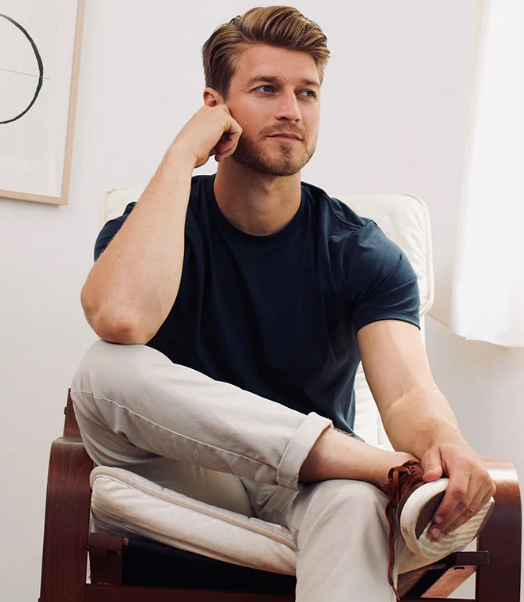
Building Your Smart-Casual Wardrobe: A Practical Guide for Men
Starting from scratch with a wardrobe can feel like a daunting task. The overwhelming choices and potential cost can quickly lead to frustration. But it doesn’t have to be this way! When I help clients begin anew, especially if their current wardrobe is outdated, I rely on a simple formula that ensures they get the most out of their purchases. It’s all about getting the right essentials to mix and match for various occasions, without feeling like you’re constantly spending.
Here’s the framework I suggest:
Essential Wardrobe = 12 Shirts + 3 Pairs of Jeans + 1 Chino + 1 Jacket + 2 Pairs of Shoes
This strategy gives you at least 50 different outfit combinations to start with. As you add new pieces, you’ll only increase your options. If you stick to a thoughtful color scheme, you can even create a capsule wardrobe. A capsule wardrobe means every top works with every bottom, though it does limit your color choices. I prefer a bit more flexibility, so while I aim for a capsule-like approach, I also encourage adding some variety.
If you’re curating your wardrobe on your own, don’t feel pressured to buy everything at once. Use this formula as a guide and make purchases that fit your needs. By focusing on quality, you’ll end up with versatile pieces that last far longer than cheaper options that wear out quickly.
The Perfect 12 Shirts
The cornerstone of any smart-casual wardrobe is a solid selection of shirts. Your “perfect dozen” should be a mix of button-downs, henleys, polo shirts, and t-shirts, offering flexibility for every event.
A typical breakdown might look like this:
- 4 Button-Downs
- 3 Henleys
- 2 Polo Shirts
- 3 T-shirts
However, this will vary depending on your personal taste. If button-downs are your go-to and you prefer henleys, feel free to adjust the ratio.
Polo Shirts
Polos are a great option because they can be dressed up or down, and they pair well with everything from chinos to shorts. Choose modern, simple polos in subtle colors—avoid the flashy, sporty polos you see everywhere. Opt for colors like burgundy or olive, as they work well in both day and night settings.
T-Shirts
A classic black or grey t-shirt is always a winner, and adding a pop of color—like a deep green—gives you more variety. Remember, a well-fitted t-shirt paired with boots and tailored jeans can be just as fashionable as any button-down.
Henleys
Henleys, which are long-sleeve shirts with a few buttons at the top, are a versatile addition to your wardrobe. They offer a casual alternative to a button-down and come in many fabrics, from casual cotton to more sophisticated cotton blends. I like choosing neutral tones like grey, cream, and blue, which can easily be dressed up or down.
Button-Down Shirts
Button-downs should be a key part of your collection. Choose a mix of patterns and solid colors—think plaid, stripes, or subtle micro-prints. A solid light grey or blue button-down can be worn tucked or untucked, depending on the occasion.
Your selection of shirts should be adaptable to your lifestyle and local climate. If you live in a warmer place, for instance, you might prefer short-sleeve button-downs and henleys instead of long sleeves.
3 Pairs of Jeans
Next, you’ll want at least three pairs of jeans. These don’t need to match every shirt, but aim to ensure each shirt goes with at least two pairs of pants. Dark blue and black jeans, for instance, will work with nearly all your shirts. Adding a third pair in a neutral dark grey will expand your options even further.
If you’re in a warmer climate, you could substitute a pair of shorts instead of the third pair of jeans.
A Pair of Chinos
Chinos are a great way to break up your denim-heavy wardrobe. A light-colored chino, such as a stone or beige shade, pairs well with both casual and dressier shirts. This is particularly useful as the seasons change—wear them with a t-shirt and sneakers in the summer or pair them with a jacket for colder months.
A Minimalist Jacket
The right jacket can complete any outfit. Keep it simple and understated—think navy blue or black for maximum versatility. A collar jacket is a great choice because it complements everything from casual t-shirts to dressier button-downs. The key is to pick a style and weight that suits your local climate. If you live in a cold area, a wool coat or peacoat might be necessary, but if it’s warm, a lightweight linen jacket will suffice.
Two Essential Pairs of Shoes
To start off, I recommend two pairs of shoes: one smart-casual boot and one sleek leather sneaker. The boot is perfect for dressing up a simple t-shirt and jeans, while the sneaker keeps the look casual but polished.
A brown Chukka boot is a versatile choice, adding a pop of color to a mostly muted wardrobe. Alternatively, a black boot works well with almost any outfit, providing a more understated look. For the sneakers, stick to a clean, minimal design in black, white, or light grey.
Avoid athletic-style running shoes—save those for the gym. Leather sneakers will elevate your look, providing comfort without sacrificing style.
Expanding Your Wardrobe
Once you’ve got your foundational pieces in place, you can start adding more variety. Sweaters, cardigans, and even stylish sweatshirts will add layers to your smart-casual wardrobe. You can also experiment with colored bottoms, like burgundy or green chinos, which pair wonderfully with neutral tops like grey, white, or navy blue.
By sticking to these essentials and gradually expanding, you’ll be well on your way to a functional, stylish wardrobe without the overwhelming feeling of constant shopping. Each piece you add will give you more outfit options and keep your style fresh and versatile.
